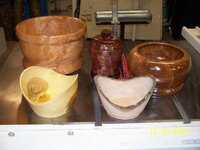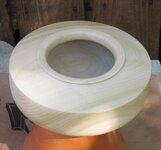I bought a nice bowl blank, fresh cut and dipped in wax. Now my question is, how long do I let it dry? Do I melt the wax off it? Or will it dry with the wax on? I know several folks here turn them about 3/4 done then shelve them for a year or two. Don't they also split that way? Sorry about all the questions, I usually buy dry wood, but it's becoming hard to find at prices I can afford.
Thanks for your time.
It is a fact most people prefer to buy dry woods ready to work, and those are always more expensive and not so easy to find. As a self wood gatherer wood-turner, wood-worker and wood seller, I've got a good understanding of the issue and while I prefer to put woods for sale only when they are at least @ -20%MC (moisture content) some of these woods are not yet dry enough to be safe on a start to finish turning piece.
If you need to buy your wood, try to buy a few blanks as often as you can and if they are very green to not yet ready, you can always decide on the common rough turning method and perform one of many systems that will allow that piece to dry out within a controlled environment . If they are green fully waxed and you don't want to turn then yet, leaving them fully covered with wax, will take twice longer to dry then, if you remove the wax from the flat surfaces and leave the wax only on the end-grain of the blank, where it tend to be more prone to splitting without waxing, this way allowing the wood to breath and dry faster.
Buying regularly, will allow you to build a stock of blanks that will have all stages of drying, after a little while and in no time you have always something dry enough to work with, and not having to buy and pay the excess cost of getting them ready to go.
Unfortunately, dry kiln adds a considerable cost to the wood/blanks while air dry cost nothing (sort off...!) but it requires lots of preparation, shelving/space and a long period waiting on a shelve that can not be used for anything else. This is one of the reasons why I and many other wood suppliers, have to sell it before it dries completely, which can take 2 to 5 years, depending of the wood type and blank size...!
Almost everyone, aren't aware of how easy and cheap is to get fresh cut logs from the local dump of from the local tree guys business, they will willingly give you more wood that you can poke a stick on, not every tree has quality wood but every tree has workable wood. The process of talking to people and go for a drive, particularly if you own a chainsaw, can provide better results than you think and or expect. A carton of beer for the tree guys, can get you the logs dropped at your front stairs, you you are in within reasonable distance from the job and the dump, well you may find there a bit of everything including some of the best woods sourced for wood-turning, that people didn't want...!
Painting the ends of the logs with any acrylic house paint, will keep it from cracking too badly, cutting the log's length a couple of inches longer than its diameter and then slipping the log in 2 halves (painting the end-grain) is the best way to preserved the wood for later. Green rough turning is the most economical way to produce turned items such as bowls, platters, plates, etc. It produces no dust, is easy on the tools cutting edges less strain on the lathe's motor, less strain on your arms, compared with heavy dense hardwoods.
By performing one of the many drying process available (some good ones mentioned above), after a few months doing it, you no longer need to be chasing/buying dry wood bowls to turn as the firs ones in the process line are ready and every week you will have a new batch of dry blanks. The quantity and time frame in between batches, is proportional to the number and how often you put blanks in the drying shelf already rough turned and treated. You find that 3 or 4 blanks rough turned every week will reach a point where, the blanks on the drying shelve, will stay there a lot longer than needed as you are too busy finishing the dry stuff...!
Obviously, all these suggestions do not help me much to sell my blanks BUT, that is not critical or something that I stress about, there will be always people out there that will never chase green logs and or go through the whole pain so, I will have always some wood for them, what I'm trying to achieve is the reduction of wasted wood that I see everyday, everywhere...!
Good luck...!
Cheers
George


